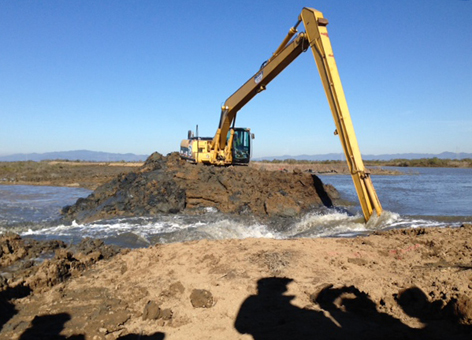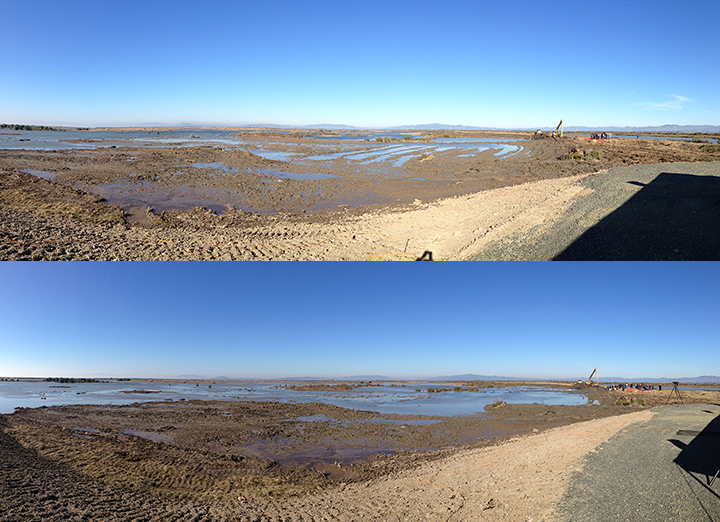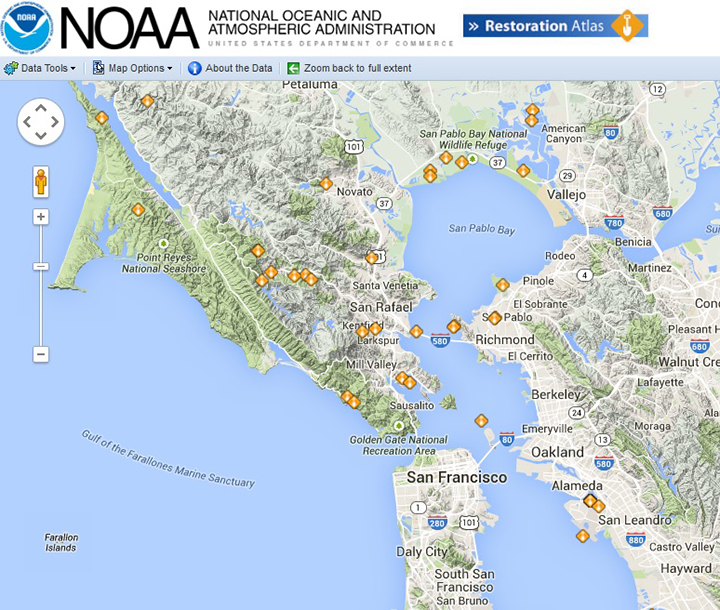After a Century Apart, NOAA and Partners Reunite a Former Wetland with San Francisco Bay's Tides
JANUARY 8, 2015 -- Scooping away the last narrow band of mud, a bright yellow excavator released a rush of brackish water into an area cut off from the tides for more than a hundred years. The 1,200 acre field now filling with water, known as Cullinan Ranch due to its history as a hay farm, is once again becoming a tidal wetland. On January 6, 2015, more than 100 people celebrated the reintroduction of tide waters to Cullinan Ranch in Solano County, California. For decades before, earthen levees had separated it from the nearby Napa River and San Pablo Bay, a northern corner of the San Francisco Bay Estuary. With three more levee breaches planned by the end of January, restoration of this 1,500 acre site is nearly complete, with efforts to monitor the project's progress to follow. Surrounded by state and federal wildlife lands, Cullinan Ranch will fill in a gap in coastal habitat as it becomes integrated with San Pablo Bay National Wildlife Refuge.

How Low Can It Flow
For the most part, Cullinan Ranch will be covered in open water because years of farming, beginning in the 1880s, caused the land to sink below sea level. The open water will provide places for animals such as fish and birds—as well as the invertebrates they like to eat—to find food and rest after big storms. However, some areas of the property will remain above the low tide level, creating conditions for the plant pickleweed to thrive. While a succulent like cacti, pickleweed can survive wet and salty growing conditions. (Fun fact: Some people enjoy cooking and eating pickleweed. When blanched, it apparently tastes salty and somewhat crispy.) The salt marsh harvest mouse, native to California and one of the few mammals able to drink saltwater, also will take advantage of the habitat created by the pickleweed in the recovering wetland.

Wildlife will not be the only ones enjoying the restoration of Cullinan Ranch. A major highway passes by the site, and Cullinan Ranch has experienced numerous upgrades to improve recreational access for people brought there by Highway 37. Soon anyone will be able to hike on the newly constructed trails, fish off the pier, and launch kayaks from the dock.
Turning Money into Marshes
The restoration of Cullinan Ranch from hay field to tidal wetland has been in the works for a long time, brought about by a range of partners and funding agencies, including NOAA, the U.S. Fish and Wildlife Service, the U.S. Environmental Protection Agency, California Department of Fish and Wildlife, California Wildlife Conservation Board, and Ducks Unlimited. NOAA provided several sources of funding to help finish this restoration project. In addition to $900,000 from the American Recovery and Reinvestment Act, NOAA contributed $650,000 through a community-based restoration partnership with Ducks Unlimited and $1.65 million awarded for natural resource damages through the Castro Cove trustee council. The latter funding was part of a $2.65 million settlement with Chevron as a result of the nearby Chevron Richmond Refinery discharging mercury and oil pollution into Castro Cove for years. Cullinan Ranch and Breuner Marsh are the two restoration projects Chevron funded to make up for this pollution.

Cullinan Ranch is one of the largest restoration projects in the north San Francisco Bay, but it is far from the only one NOAA is involved with in the region. Helping reverse a century-long trend which saw many of the bay's tidal wetlands disappear, NOAA has been working on a suite of projects restoring these historic and important coastal features in northern California. Watch footage of the earthen levee being breached to reconnect the bay's tide waters to Cullinan Ranch:
